TOYOTA VERSO 2012 Owners Manual
Manufacturer: TOYOTA, Model Year: 2012, Model line: VERSO, Model: TOYOTA VERSO 2012Pages: 588, PDF Size: 31.32 MB
Page 141 of 588
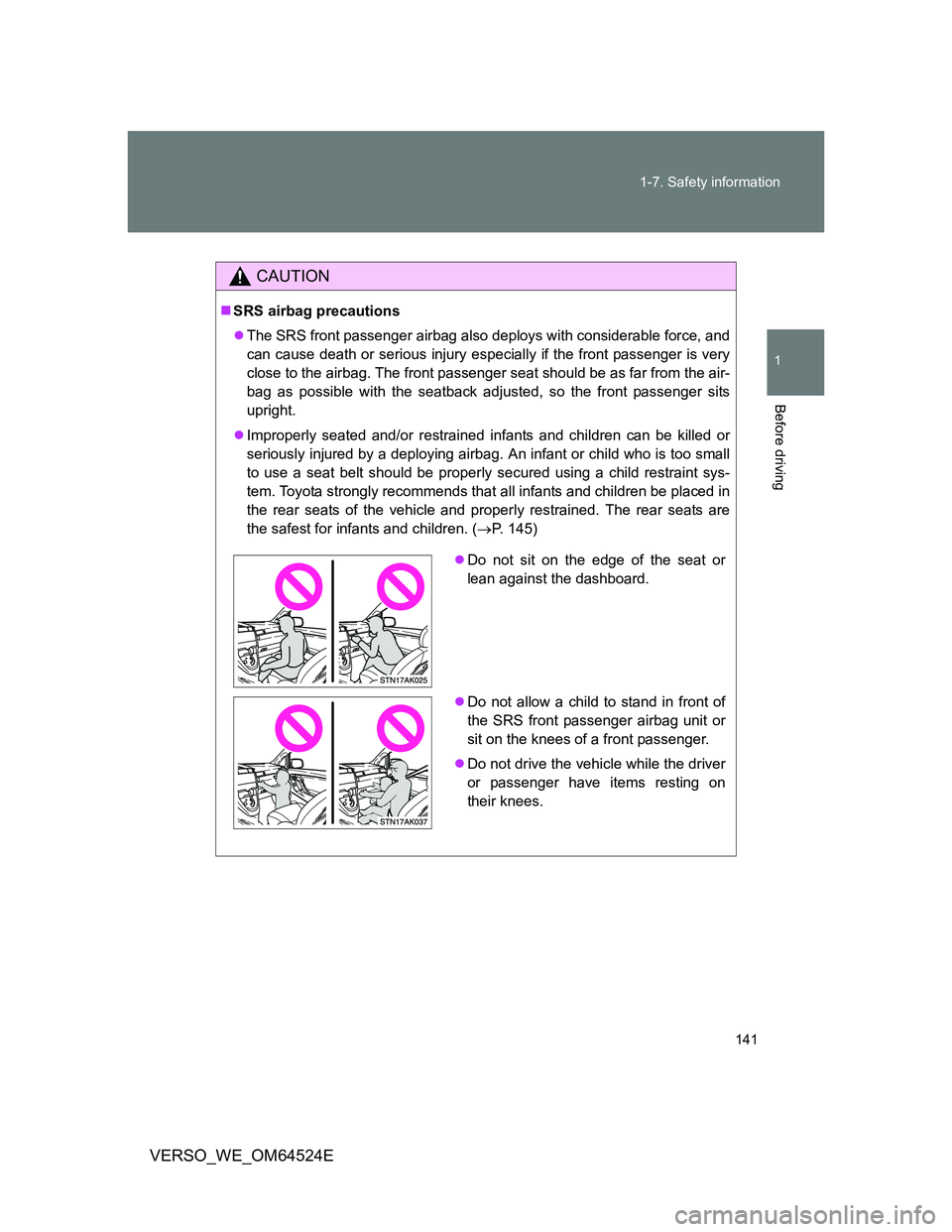
141 1-7. Safety information
1
Before driving
VERSO_WE_OM64524E
CAUTION
SRS airbag precautions
The SRS front passenger airbag also deploys with considerable force, and
can cause death or serious injury especially if the front passenger is very
close to the airbag. The front passenger seat should be as far from the air-
bag as possible with the seatback adjusted, so the front passenger sits
upright.
Improperly seated and/or restrained infants and children can be killed or
seriously injured by a deploying airbag. An infant or child who is too small
to use a seat belt should be properly secured using a child restraint sys-
tem. Toyota strongly recommends that all infants and children be placed in
the rear seats of the vehicle and properly restrained. The rear seats are
the safest for infants and children. (P. 145)
Do not sit on the edge of the seat or
lean against the dashboard.
Do not allow a child to stand in front of
the SRS front passenger airbag unit or
sit on the knees of a front passenger.
Do not drive the vehicle while the driver
or passenger have items resting on
their knees.
Page 142 of 588
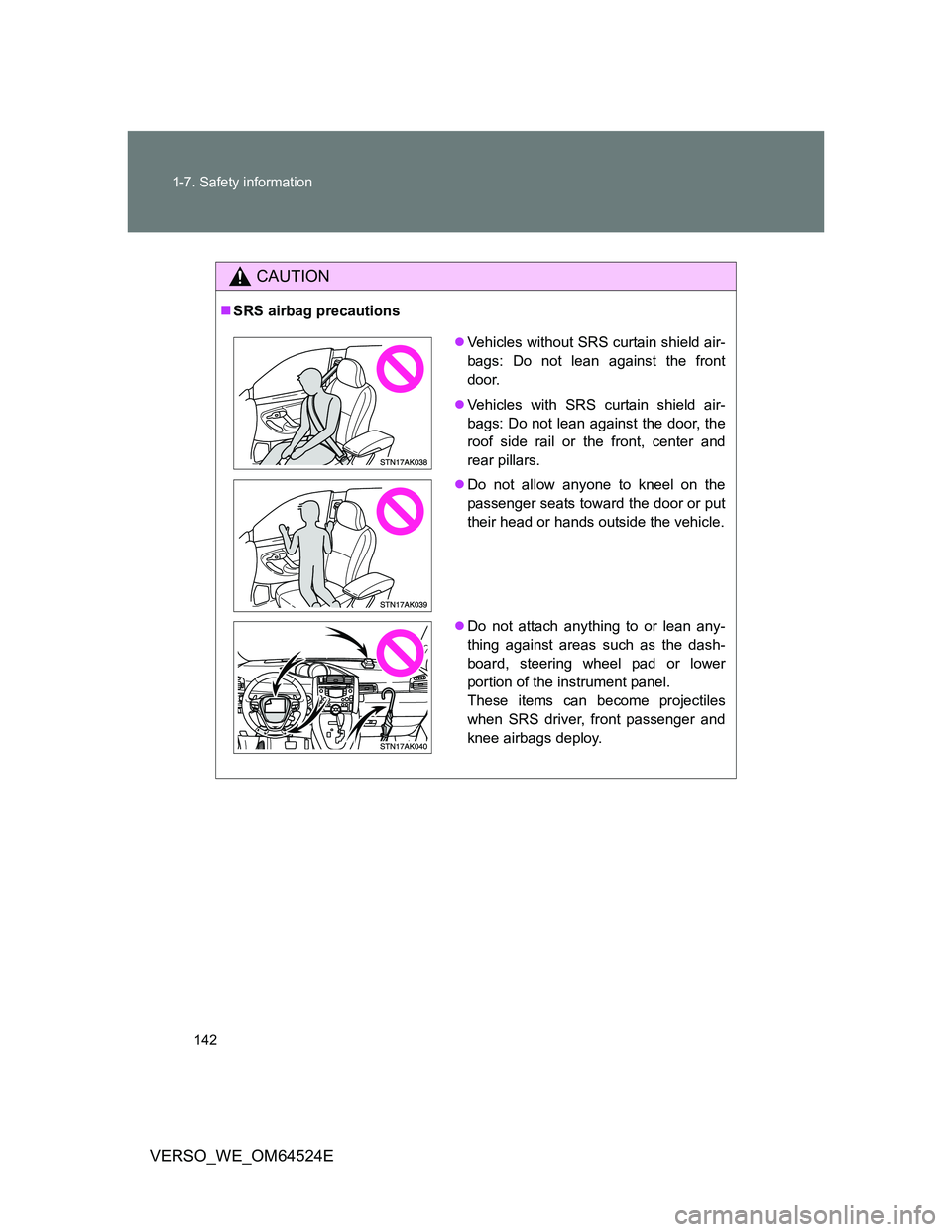
142 1-7. Safety information
VERSO_WE_OM64524E
CAUTION
SRS airbag precautions
Vehicles without SRS curtain shield air-
bags: Do not lean against the front
door.
Vehicles with SRS curtain shield air-
bags: Do not lean against the door, the
roof side rail or the front, center and
rear pillars.
Do not allow anyone to kneel on the
passenger seats toward the door or put
their head or hands outside the vehicle.
Do not attach anything to or lean any-
thing against areas such as the dash-
board, steering wheel pad or lower
portion of the instrument panel.
These items can become projectiles
when SRS driver, front passenger and
knee airbags deploy.
Page 143 of 588
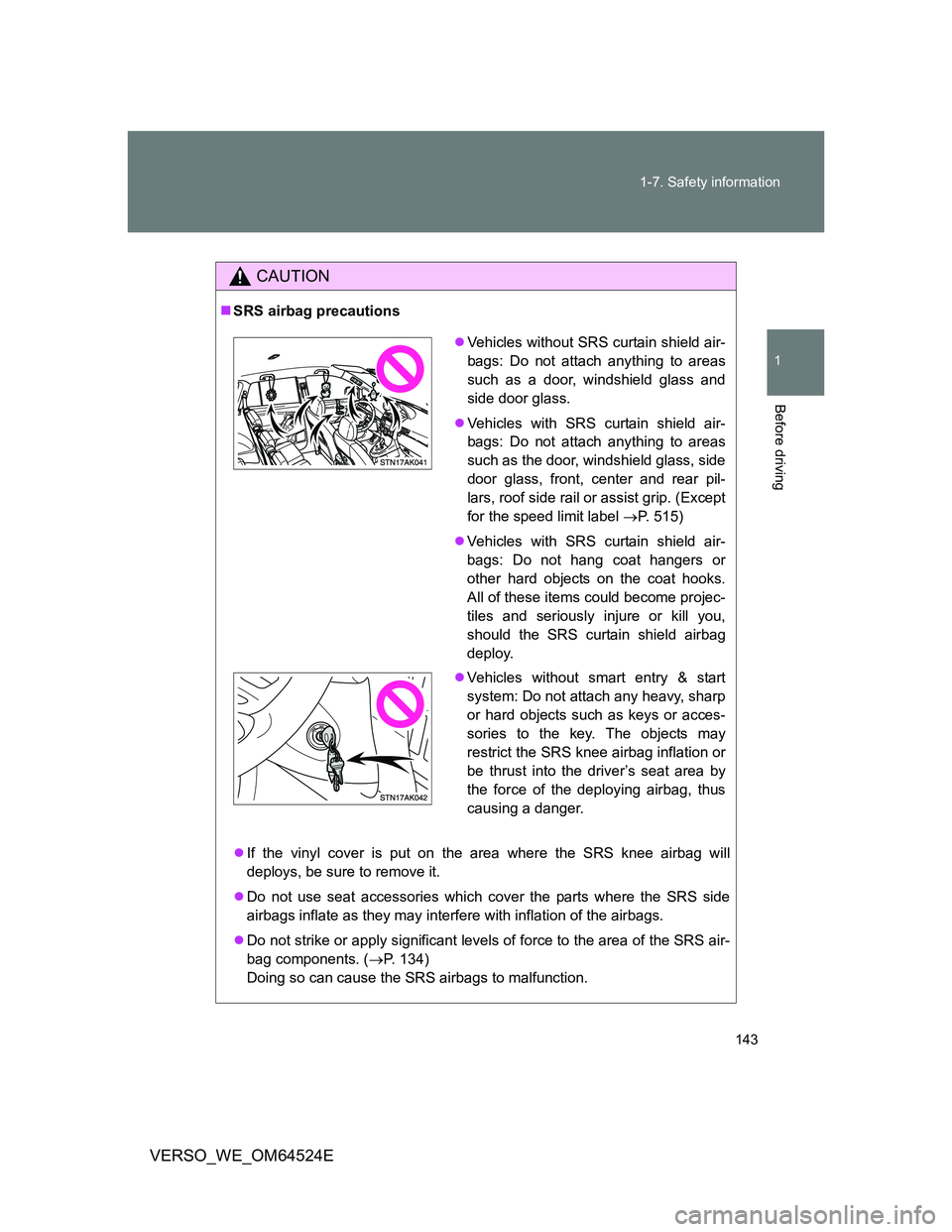
143 1-7. Safety information
1
Before driving
VERSO_WE_OM64524E
CAUTION
SRS airbag precautions
If the vinyl cover is put on the area where the SRS knee airbag will
deploys, be sure to remove it.
Do not use seat accessories which cover the parts where the SRS side
airbags inflate as they may interfere with inflation of the airbags.
Do not strike or apply significant levels of force to the area of the SRS air-
bag components. (P. 134)
Doing so can cause the SRS airbags to malfunction.
Vehicles without SRS curtain shield air-
bags: Do not attach anything to areas
such as a door, windshield glass and
side door glass.
Vehicles with SRS curtain shield air-
bags: Do not attach anything to areas
such as the door, windshield glass, side
door glass, front, center and rear pil-
lars, roof side rail or assist grip. (Except
for the speed limit label P. 515)
Vehicles with SRS curtain shield air-
bags: Do not hang coat hangers or
other hard objects on the coat hooks.
All of these items could become projec-
tiles and seriously injure or kill you,
should the SRS curtain shield airbag
deploy.
Vehicles without smart entry & start
system: Do not attach any heavy, sharp
or hard objects such as keys or acces-
sories to the key. The objects may
restrict the SRS knee airbag inflation or
be thrust into the driver’s seat area by
the force of the deploying airbag, thus
causing a danger.
Page 144 of 588
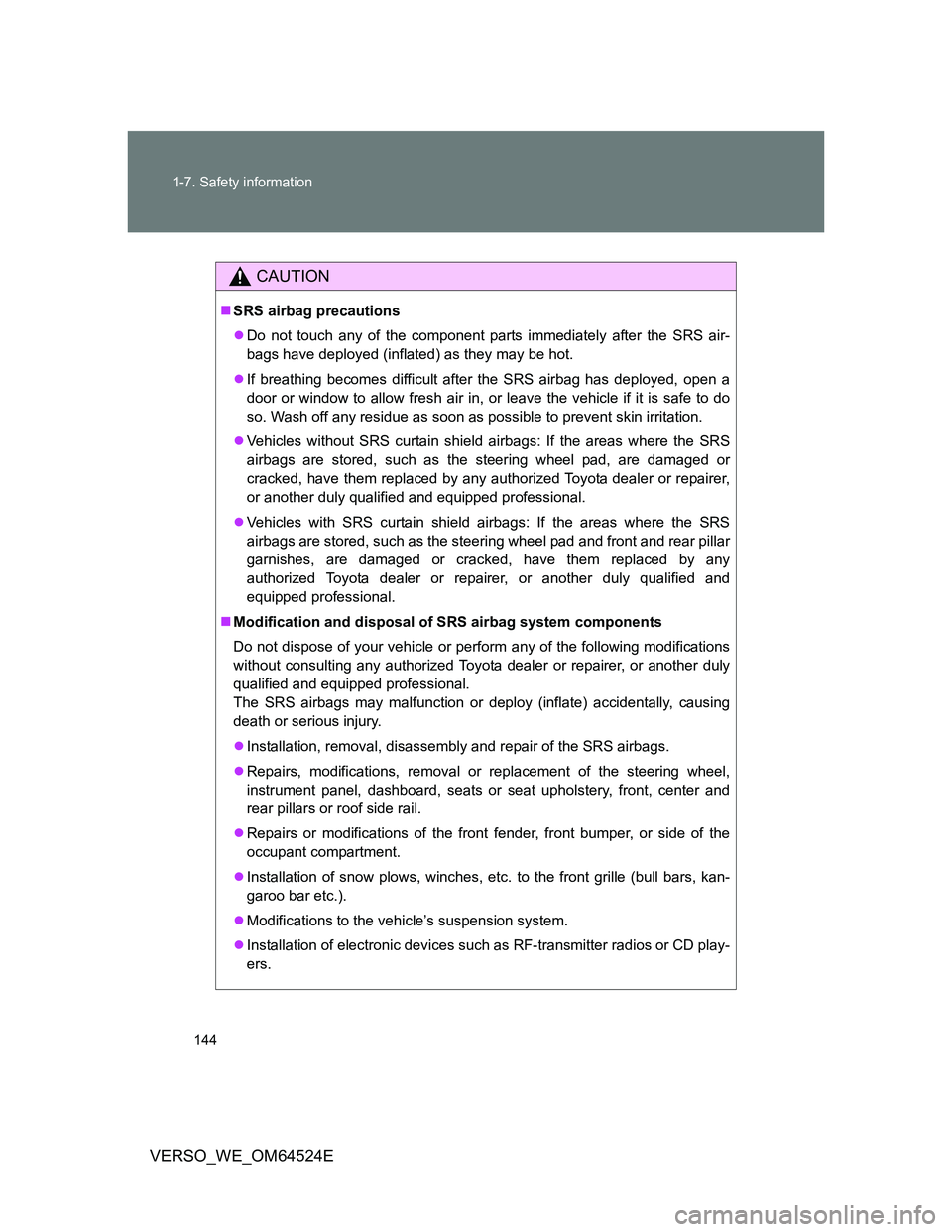
144 1-7. Safety information
VERSO_WE_OM64524E
CAUTION
SRS airbag precautions
Do not touch any of the component parts immediately after the SRS air-
bags have deployed (inflated) as they may be hot.
If breathing becomes difficult after the SRS airbag has deployed, open a
door or window to allow fresh air in, or leave the vehicle if it is safe to do
so. Wash off any residue as soon as possible to prevent skin irritation.
Vehicles without SRS curtain shield airbags: If the areas where the SRS
airbags are stored, such as the steering wheel pad, are damaged or
cracked, have them replaced by any authorized Toyota dealer or repairer,
or another duly qualified and equipped professional.
Vehicles with SRS curtain shield airbags: If the areas where the SRS
airbags are stored, such as the steering wheel pad and front and rear pillar
garnishes, are damaged or cracked, have them replaced by any
authorized Toyota dealer or repairer, or another duly qualified and
equipped professional.
Modification and disposal of SRS airbag system components
Do not dispose of your vehicle or perform any of the following modifications
without consulting any authorized Toyota dealer or repairer, or another duly
qualified and equipped professional.
The SRS airbags may malfunction or deploy (inflate) accidentally, causing
death or serious injury.
Installation, removal, disassembly and repair of the SRS airbags.
Repairs, modifications, removal or replacement of the steering wheel,
instrument panel, dashboard, seats or seat upholstery, front, center and
rear pillars or roof side rail.
Repairs or modifications of the front fender, front bumper, or side of the
occupant compartment.
Installation of snow plows, winches, etc. to the front grille (bull bars, kan-
garoo bar etc.).
Modifications to the vehicle’s suspension system.
Installation of electronic devices such as RF-transmitter radios or CD play-
ers.
Page 145 of 588
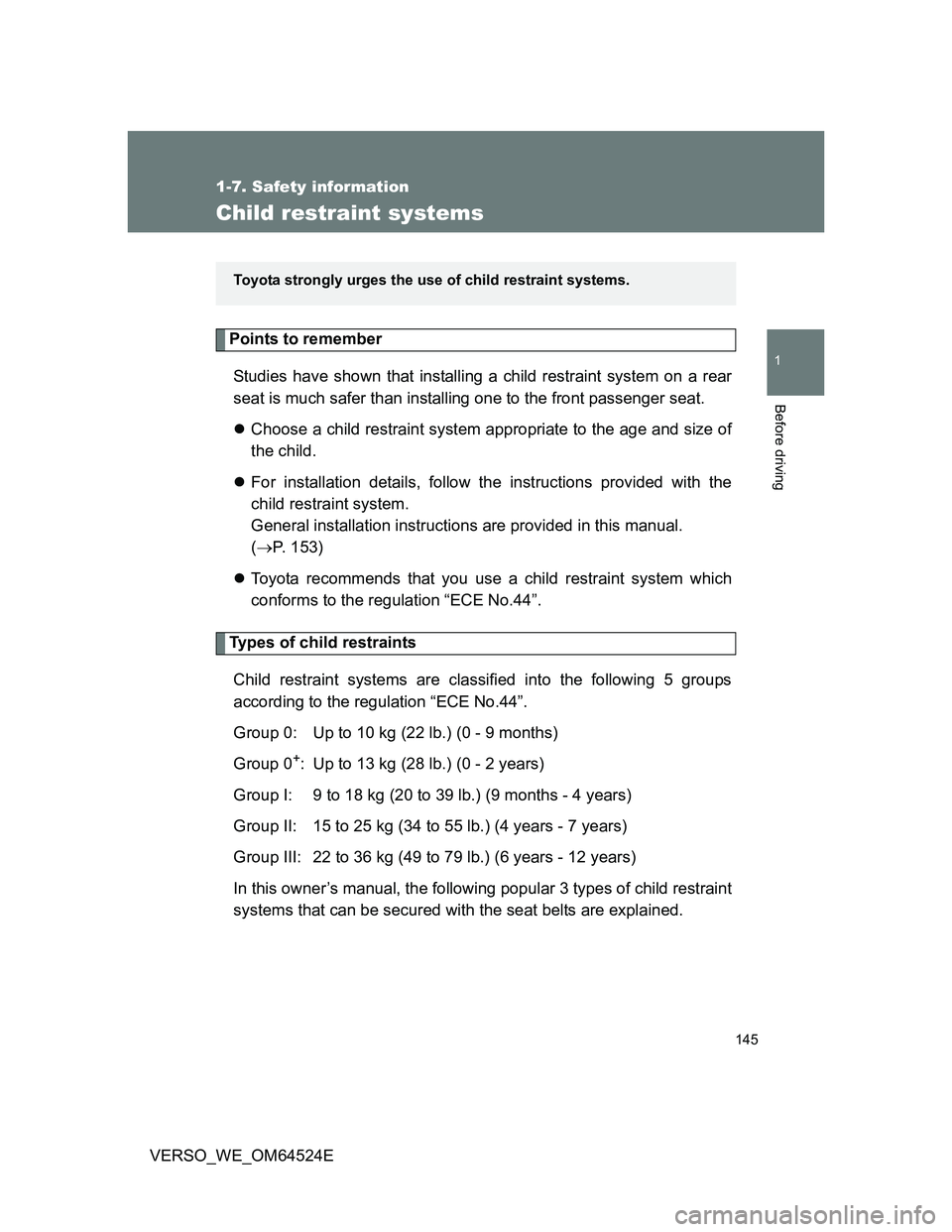
145
1
1-7. Safety information
Before driving
VERSO_WE_OM64524E
Child restraint systems
Points to remember
Studies have shown that installing a child restraint system on a rear
seat is much safer than installing one to the front passenger seat.
Choose a child restraint system appropriate to the age and size of
the child.
For installation details, follow the instructions provided with the
child restraint system.
General installation instructions are provided in this manual.
(P. 153)
Toyota recommends that you use a child restraint system which
conforms to the regulation “ECE No.44”.
Types of child restraints
Child restraint systems are classified into the following 5 groups
according to the regulation “ECE No.44”.
Group 0: Up to 10 kg (22 lb.) (0 - 9 months)
Group 0
+: Up to 13 kg (28 lb.) (0 - 2 years)
Group I: 9 to 18 kg (20 to 39 lb.) (9 months - 4 years)
Group II: 15 to 25 kg (34 to 55 lb.) (4 years - 7 years)
Group III: 22 to 36 kg (49 to 79 lb.) (6 years - 12 years)
In this owner’s manual, the following popular 3 types of child restraint
systems that can be secured with the seat belts are explained.
Toyota strongly urges the use of child restraint systems.
Page 146 of 588
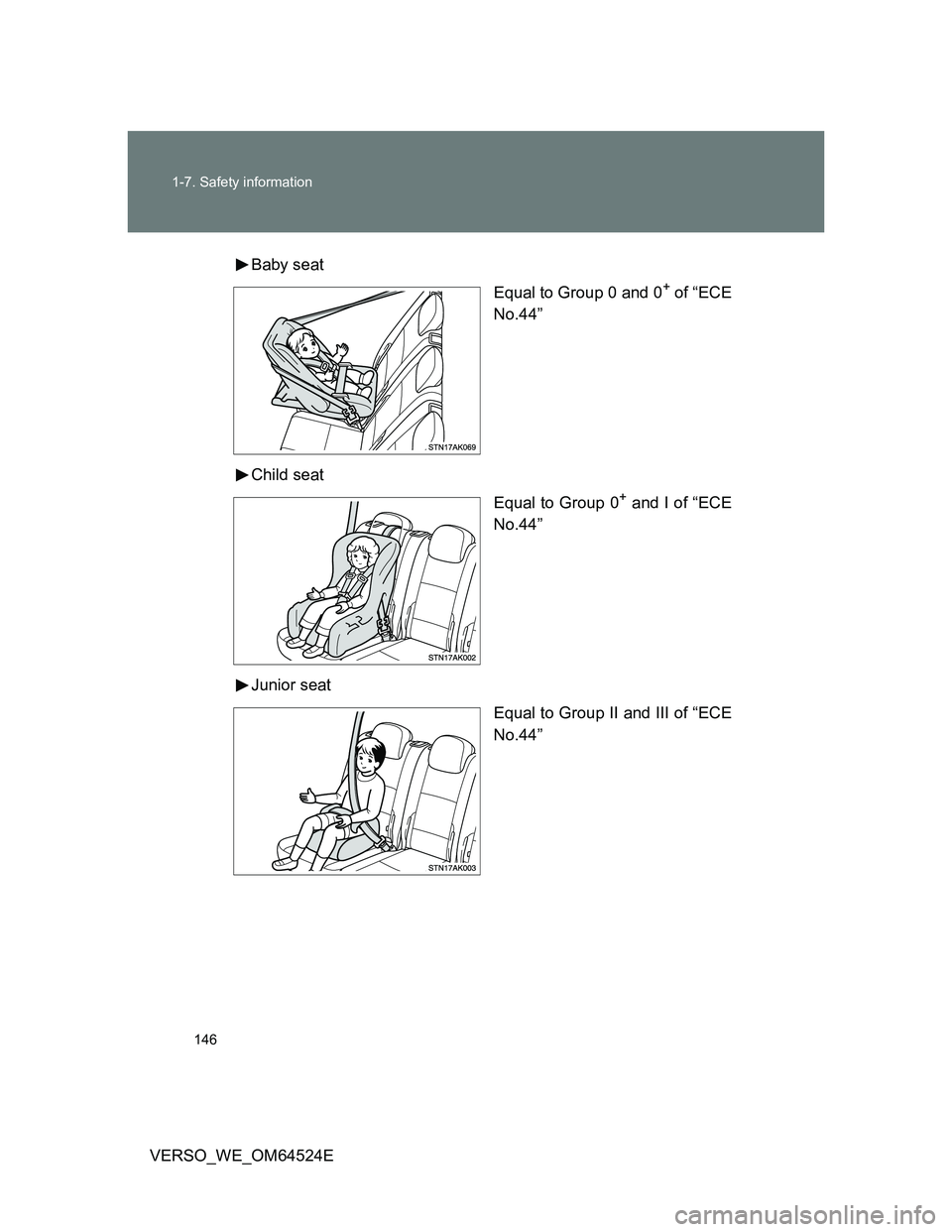
146 1-7. Safety information
VERSO_WE_OM64524EBaby seat
Equal to Group 0 and 0
+ of “ECE
No.44”
Child seat
Equal to Group 0
+ and I of “ECE
No.44”
Junior seat
Equal to Group II and III of “ECE
No.44”
Page 147 of 588
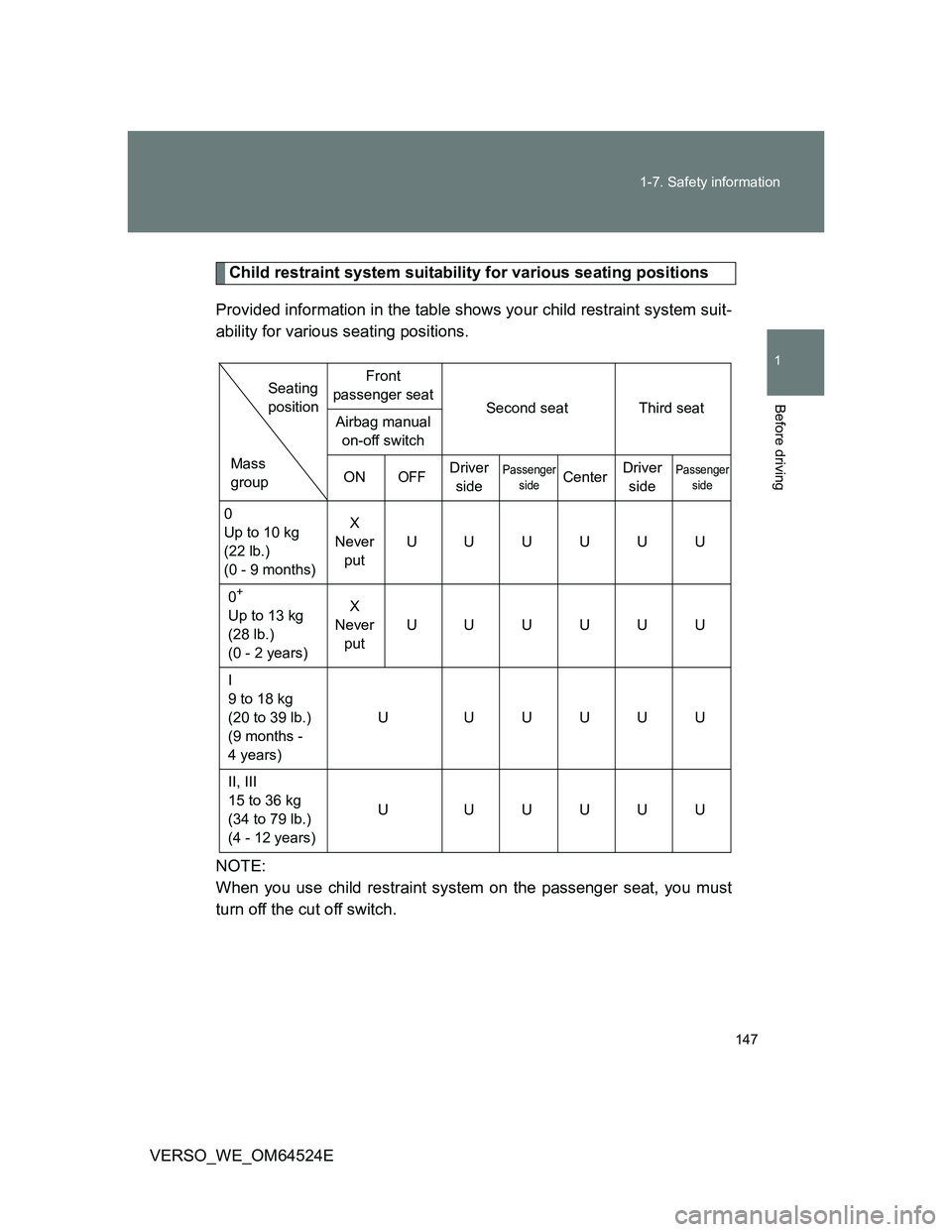
147 1-7. Safety information
1
Before driving
VERSO_WE_OM64524E
Child restraint system suitability for various seating positions
Provided information in the table shows your child restraint system suit-
ability for various seating positions.
NOTE:
When you use child restraint system on the passenger seat, you must
turn off the cut off switch.
Front
passenger seat
Second seat Third seat
Airbag manual
on-off switch
ON
OFFDriver
sidePassenger
sideCenterDriver
sidePassenger
side
0
Up to 10 kg
(22 lb.)
(0 - 9 months)X
Never
putUUUUUU
0
+
Up to 13 kg
(28 lb.)
(0 - 2 years)X
Never
putUUUUUU
I
9 to 18 kg
(20 to 39 lb.)
(9 months -
4 years)U UUUUU
II, III
15 to 36 kg
(34 to 79 lb.)
(4 - 12 years)U UUUUU
Mass
groupSeating
position
Page 148 of 588
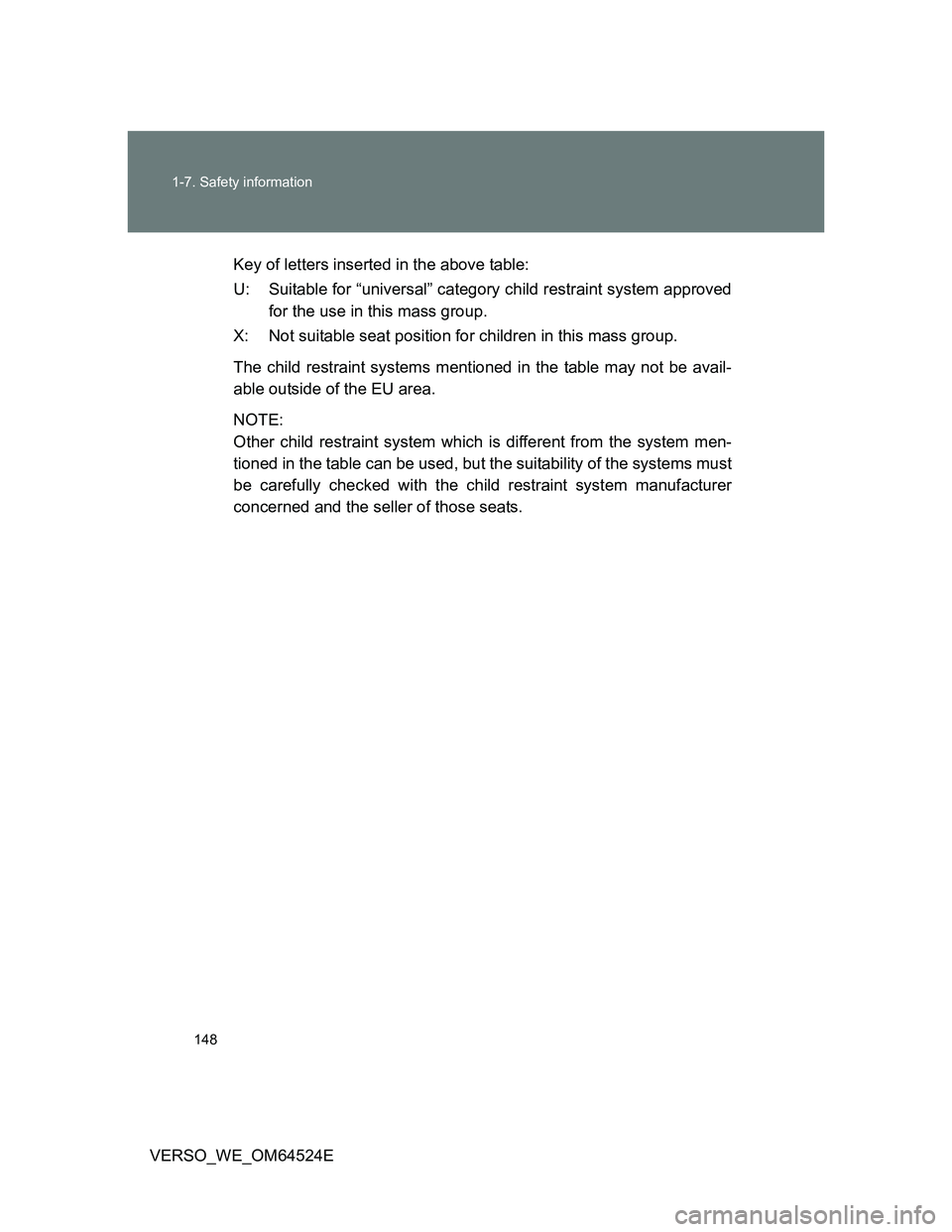
148 1-7. Safety information
VERSO_WE_OM64524EKey of letters inserted in the above table:
U: Suitable for “universal” category child restraint system approved
for the use in this mass group.
X: Not suitable seat position for children in this mass group.
The child restraint systems mentioned in the table may not be avail-
able outside of the EU area.
NOTE:
Other child restraint system which is different from the system men-
tioned in the table can be used, but the suitability of the systems must
be carefully checked with the child restraint system manufacturer
concerned and the seller of those seats.
Page 149 of 588
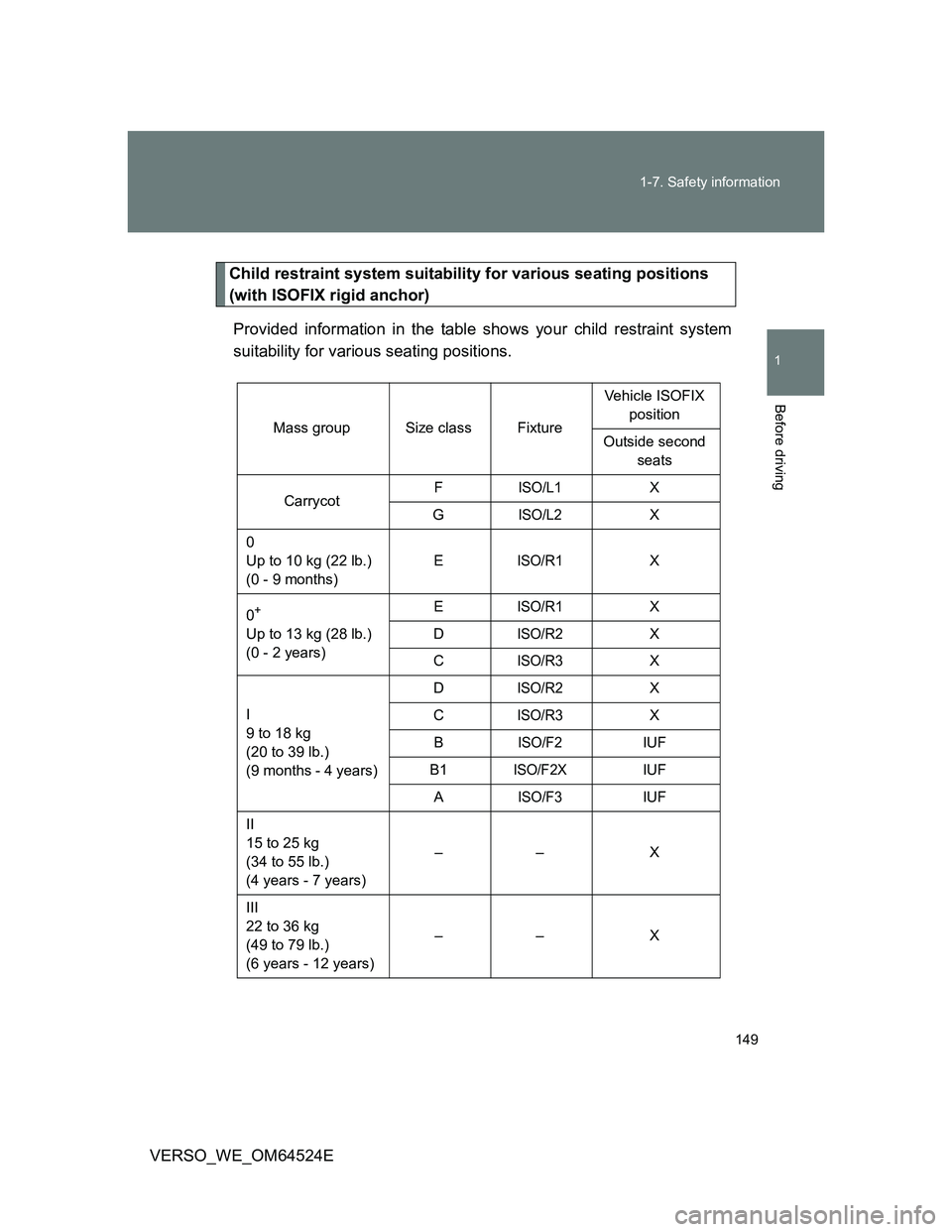
149 1-7. Safety information
1
Before driving
VERSO_WE_OM64524E
Child restraint system suitability for various seating positions
(with ISOFIX rigid anchor)
Provided information in the table shows your child restraint system
suitability for various seating positions.
Mass group Size class FixtureVehicle ISOFIX
position
Outside second
seats
CarrycotF
ISO/L1X
G
ISO/L2X
0
Up to 10 kg (22 lb.)
(0 - 9 months)E
ISO/R1X
0
+
Up to 13 kg (28 lb.)
(0 - 2 years)E
ISO/R1X
D
ISO/R2X
C
ISO/R3X
I
9 to 18 kg
(20 to 39 lb.)
(9 months - 4 years)D
ISO/R2X
C
ISO/R3X
B
ISO/F2IUF
B1
ISO/F2XIUF
A
ISO/F3IUF
II
15 to 25 kg
(34 to 55 lb.)
(4 years - 7 years)–– X
III
22 to 36 kg
(49 to 79 lb.)
(6 years - 12 years)–– X
Page 150 of 588
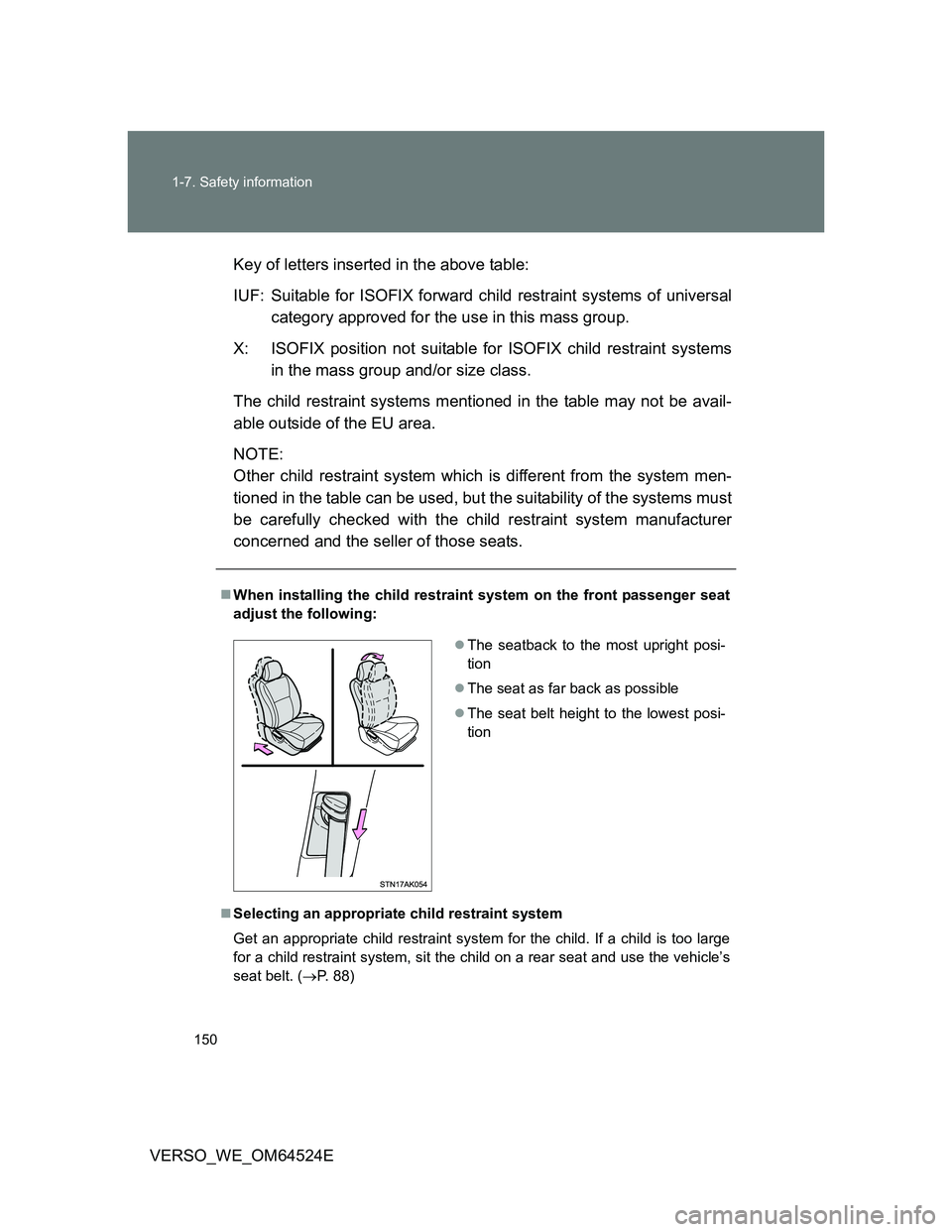
150 1-7. Safety information
VERSO_WE_OM64524EKey of letters inserted in the above table:
IUF: Suitable for ISOFIX forward child restraint systems of universal
category approved for the use in this mass group.
X: ISOFIX position not suitable for ISOFIX child restraint systems
in the mass group and/or size class.
The child restraint systems mentioned in the table may not be avail-
able outside of the EU area.
NOTE:
Other child restraint system which is different from the system men-
tioned in the table can be used, but the suitability of the systems must
be carefully checked with the child restraint system manufacturer
concerned and the seller of those seats.
When installing the child restraint system on the front passenger seat
adjust the following:
Selecting an appropriate child restraint system
Get an appropriate child restraint system for the child. If a child is too large
for a child restraint system, sit the child on a rear seat and use the vehicle’s
seat belt. (P. 88)
The seatback to the most upright posi-
tion
The seat as far back as possible
The seat belt height to the lowest posi-
tion